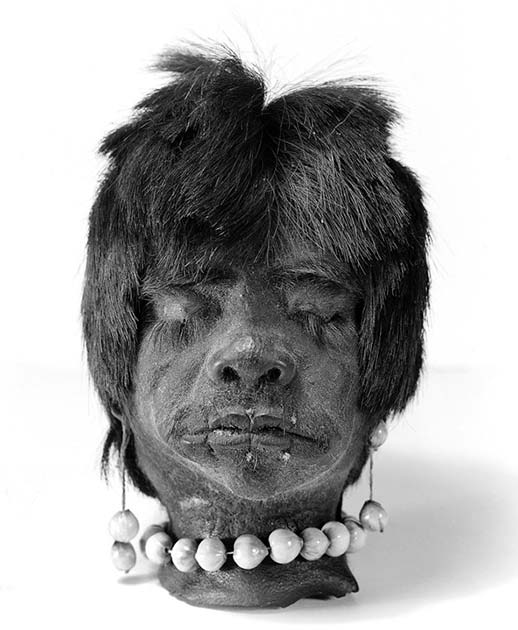Jivaro's Macabre Mastery: The Enigmatic Shrunken Heads of Jivaro
Headhunting is a practice that has been carried out by numerous cultures throughout the world. For instance, during the Qin Dynasty in ancient China, it is claimed that soldiers collected the heads of their dead enemies and tied them around their waists. This was intended to terrorize and demoralize their enemies. Even though headhunting was not too uncommon a practice, the shrinking of human heads is one that was practiced by the Jivaro Indians of Ecuador and Peru. The shrunken heads of the Jivaro were a special form of trophy obtained from their defeated enemies.

One of the shrunken heads of Jivaro. (Wellcome Images / CC BY 4.0)
Shrunken Heads of Jivaro: The Macabre Art of Trophy-Making
The process of making a shrunken head began by obtaining a human head in battle. A head was removed from the body by cutting the skin at the extreme base of the neck, just above the clavicles and in a ‘V’ shape meeting at the point between the nipples. A hair band or vine was then passed through the open mouth and out of the mouth. This allowed the warrior to carry his trophy home with ease.
- Headhunting and Shrunken Heads: Gruesome Ancient War Trophies
- European Governments Offered Rewards for Native American Scalps
Once back in his home, the warrior would make an incision up the back of the neck in order to peel the flesh away from the skull. The entire skull was then removed and thrown away. The eyes were sewn shut, and the mouth closed by passing small, sharp palm pegs through the lips. Then, the skin was put into a boiling pot and left to simmer for about an hour and a half to two hours.
When creating the shrunken heads of Jivaro, timing was crucial; too short a time would result in the head not shrinking properly, while leaving the head too long in the pot would cause the hair on the head to fall out. When the head was removed from the pot, it would be reduced by two-thirds of its original size and would have a rubbery texture. The skin was then turned inside out, and any flesh left on the inside of the skin was scraped away.

An indigenous hunter of the Amazon basin with a blowgun. (Ammit / Adobe Stock)
Crafting the Mystical Shrunken Heads of Jivaro
After this, the head was dried so that it would continue to shrink. Small rocks heated by a fire were used to fill the cavity of the head. When the head becomes too small for the stones, heated sand was used instead. In addition, heated rocks were applied to the outside of the head to maintain the features.
The entire process of creating one of these shrunken heads of Jivaro lasted several days, after which the pegs through the lips were removed and replaced with dangling cotton cords. Ash was then rubbed into the skin, and the head hung over a fire to allow it to dry and harden. Once this was completed, the head was attached to a cord through the scalp and worn around the warrior’s neck.
The process of producing the shrunken head ended with a celebration and a feast. Once these rituals were complete, the shrunken head had served its purpose for the warrior. Its significance was in the process of its creation, and not the final product.
Jivaro Warfare and the Shrunken Heads of Jivaro
Interestingly, Jivaro warfare was motivated by revenge, rather than territorial expansion. Thus, raids on enemy settlements were performed to avenge slain relatives. As a result, headhunting was undertaken to appease the spirits of slain ancestors. Jivaro warriors believed that the ritual of shrinking the head paralyzed the spirit of their foe and prevented it from taking revenge. It was also a way of passing the victim’s strength onto the killer.
- Canadian Researchers Prove Old Shrunken Head Found in Museum is Human
- “International” Shrunken Head From Ecuador Returns Home
During the 19th century, tales of the shrunken heads of Jivaro reached the ears of European and Americans. This created a demand in the market for shrunken heads, which became objects of morbid curiosity.
As a result, head shrinking was motivated not so much by vengeance, but by commercial gains. Of course, the practice of head shrinking was eventually banned due to its gruesome nature. Yet, this piece of Jivaro tradition still has its allure. Today replicas of shrunken heads are highly sought after. These are clearly labelled as replicas and are made from animal products.
Top image: A shrunken head of Jivaro on display. Source: Tylwyth Eldar / CC BY-SA 4.0
By Wu Mingren
References
Clark, J., 2014. “How Shrunken Heads Work” in howstuffworks. Available at: http://people.howstuffworks.com/shrunken-head1.htm
Eveleth, R. 20 March 2013. “How Does One Actually Shrink a Head?” in Smithsonian Magazine. Available at: http://www.smithsonianmag.com/smart-news/how-does-one-actually-shrink-a-head-5994665/
Krystek, L., 2011. “The Head Shrinkers of South America” in The Museum of Unnatural Mystery. Available at: http://www.unmuseum.org/headshrinkers.htm
Soniak, M., 2013. “How Are Shrunken Heads Made?” in Mental Floss. Available at: http://mentalfloss.com/article/33607/how-are-shrunken-heads-made


















Comments
Seriously?
I'm very interrested to see your reaction when they do something like that to a close one of yours...
Seriously??
WT#!!!
yes i agree without the money side to it i guess its ok for the tribal purposes
things i'm glad have gone out of style...
love, light and blessings
AB
none of my close ones would be stupid enough to piss off the Jivaro.
Peace and Love,
Ricky.
Same thing to you!
Seriously?
I'm very interrested to see your reaction when they do something like that to a close one of yours...
WT#!!!!!!!!!!!!!!!!!!!!!!!!!!!!!!
Pages